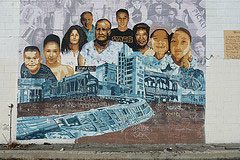
#1. Poor Asian Americans Exist
Many people who seek to debunk the model minority myth are Asian Americans who come from a middle class/upper middle class background, who are themselves likely professional and/or highly educated (I fit this description, by the way). We tend to fixate on our own experiences of the model minority myth and talk about the “bamboo ceiling,” how Asians/Asian Americans are seen as technical but not artistic, book smart but not street smart, skilled worker cogs and not leadership material, etc. This narrative paints the model minority myth as mostly disadvantaging people who are already relatively well off.
But, the model minority myth also hurts poor Asian Americans, arguably more so than it hurts well-off Asian Americans. Because of the myth (and because of aggregate metrics which are skewed by the large numbers of highly educated, professional Asian Americans), people think that poor Asian Americans don’t exist. But there are over 2 million poor Asian Americans and, since the recession, Asian Americans have had the fastest growing poverty population by race/ethnicity. And in some big cities (mostly West Coast cities like San Francisco, San Jose, and Seattle), there are more poor Asian Americans than there are poor African Americans or Latinos. But because it is presumed that all Asian Americans are well off, many mainstream public and nonprofit service agencies are unprepared in terms of language capacity, culturally competent services, and outreach to deal with poor Asian Americans. Similarly, poor Asian Americans are disproportionately underserved by federal programs and major philanthropic institutions.
I don’t want to get into an oppression Olympics, race-to-the-bottom style of rhetoric about how my particular community of interest and identity is worse off (and therefore more deserving of services) than other communities, because it is not. Also, that is a damaging and unproductive line of thought. But we do need to have an accurate picture, which is hard to have without first establishing the fact that poor Asian Americans exist. So, when model minority myth busting, I think it’s critical to focus on the segments of our community who are the most disadvantaged. Focusing on case studies about college-bound students who don’t get into UC Berkeley or Silicon Valley tech workers who don’t move high enough or fast enough up the corporate ladder only reifies what people already think about Asian Americans—that we are only about educational achievement and corporate advancement, and are victims of diversity programs and affirmative action.
#2. Debunking the Model Minority Myth Should Be about Racial Justice
The Time piece references that “model minority” thinking was introduced into public discourse in 1966 by The New York Times and U.S. News and World Report, but does not talk explicitly about how the term was developed hand-in-hand with the concept of “problem minorities.” From the January 9, 1966 New York Times Magazine article by William Petersen, “Generally this kind of treatment [references history of discrimination faced by Japanese Americans from the late 1800s to WWII Internment], creates what might be termed ‘problem minorities.’ Each number of interrelated factors—poor health, poor education, high crime rate, unstable family pattern, and so on and on—reinforces all the others and together they make up the reality of slum life.” But that, “[t]he history of Japanese Americans, however, challenges such generalization about ethnic minorities… Barely 20 years after the end of the wartime camps, this is a minority that has risen above even prejudiced criticism. By any criterion of good citizenship that we choose, the Japanese Americans are better than any group in our society, including native-born whites. They have established this record, moreover, by their almost totally unaided effort. Every attempt to hamper their progress resulted only in enhancing their determination to succeed. Even in a country whose patron saint is the Horatio Alger hero, there is no parallel to this success story.”
Interestingly, Petersen’s article was about Japanese Americans, and he included Chinese and Filipinos in the list of minority groups, like “Negroes, Mexicans, Indians” for whom it has been difficult to overcome “color prejudice.” Over time, with successive waves of highly educated immigrants, the model minority construct has come to encompass all Asian Americans and, while no longer a politically correct term, the “problem minority” space is occupied by African Americans, Latinos, and Native Americans. But, whether explicitly so or not, “model minority” is a direct (though not always conscious) invocation of the idea of good and bad. In this rubric, good minorities take obstacles as a challenge and succeed, as good Americans do. Bad minorities are lazy, dysfunctional, and complain about challenges—blaming racism instead of looking for ways to overcome challenges. In this way, the model minority myth is an insidious, stealth tool to invalidate people’s legitimate claims about the systematic effects of racism, particularly around the role of structural racism and economic outcomes.
So, while the model minority myth puts Asian Americans in an uncomfortable box, the implicit flipside—the “problem minority” myth—is even more problematic and undermines the larger struggle for racial and economic justice. As we bust the model minority myth, we should also be explicitly advocating for racial and economic justice for all minorities.
(Photo credit: Flickr user Anna Conti Att-SA)






Comments